

| Note please: the images of the capitals and piers of the cloister are arranged in clockwise order from the northwest corner. The order of the galleries is thus: north, east, south, and west. | ||
Left: the east gallery from the north; center and right: looking northeast with the east gallery on the right. | ||
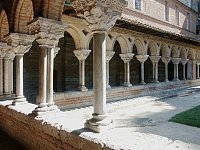
|

|
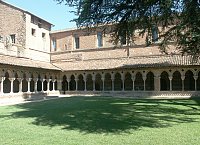
|
Pier relief of St. JohnHere the saint is barefoot, standing on stairs. He wears a skull cap of sorts with a fringe of ringlets. | ||

|

|
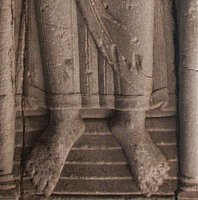
|
Center: Pier relief of St. James; right: Annunciation (right) and Visitation (left) | ||
| Mary is nearer the center with Gabriel around the corner. In the Visitation, Mary and Elizabeth, the future mother of John the Baptist, embrace. An architectural structure is in the center, although the artist uses the double scale for figures and architecture. The figures are much too large for the building. | 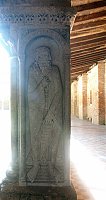
|
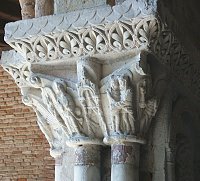
|
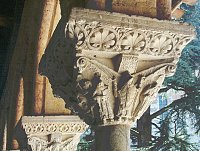
|
Martyrdoms of Saints Fructueux, Augure, and Euloge (north face of capital)The central figure is Fructueux, the bishop wearing those vestments while the deacons flank him in simpler dress. Stones explains: "Arrested on January 16, 259, in the reign of Emperor Valerian, they were imprisoned. After refusing to sacrifice to the pagan gods, they were condemned to be burned alive. However, the flames only burned the ropes that tied them to the stake- They raised their arms to form a cross, and their souls went to Heaven, though their bodies were unburned" (webpage). The figures' names are also inscribed on the capital. This capital, like many in the cloister (see below, for example, on this page) shows the influence of the Corinthian form with volutes rising to the corners. | |
Martyrdom of St. Sernin (east face)Saint Saturnin or Sernin was the first bishop of Toulouse in AD 250. His gruesome martyrdom occurred when pagan priests tied his feet to a bull so that he was dragged until the rope broke. This scene does not describe that martyrdom. A tower occupies the center, perhaps a building at Toulouse. Three figures on the right seem ominous, one with a large knife. |
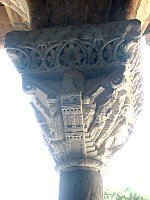
| |
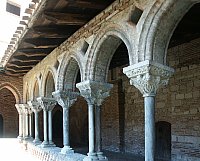
|
The northern end of the east galleryThe beautiful foliate capital is below. Palm fronds and intertwining vines comprise the graceful bottom of the capital while lion heads occupy the top. The abacus has a scallop motif at the very top (common on these capitals) while below, two lions are attacked by griffons. The three images below were photographed by my husband, William J. Sullivan. |
|
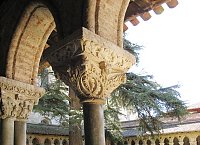
|
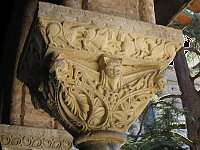
|
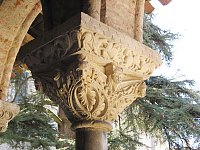
|
Adoration of the MagiLeft: north face depicts Mary seated holding the infant Jesus. She is frontal, seemingly unaware of the advancing troupe. Inscriptions also identify her. The three Magi are standing, holding their gifts. | ||

|
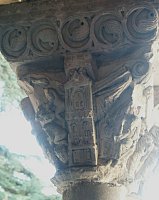
|
The flowers above represent the star they followed since it has inscriptions reading "OR" for star. Perhaps the double representation is a way of indicating movement through time. The cloaks of the Magi swing out, yet another way to suggest movement. Center: the east face depicts Bethlehem, identified by the inscription. On another face the Massacre of the Innocents is represented. |
Left: foliate capital with pine cone design in the center; center: Marriage at Cana with six figures seated at a table; right: decorative capital with birds and humans--here with a seated figure in a long robeThe medieval sculptor who designed these capitals was not interested in depicting space realistically. Here the feast table, though parallel with the apparent background, with figures shown behind it, is tipped so that the viewer can see the objects on it. (See also the capital with the depiction of the feast of Herod where the table top is tipped.) |
||

|
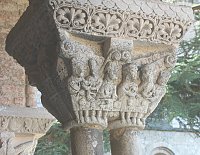
|
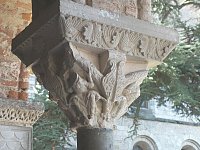
|
Works Consulted or Quoted:
Meyer Schapiro. The Sculpture of Moissac. NY: Braziller, 1985.
M. Alison Stones. Extensive medieval website.
 Go to Moissac Index.
Go to Moissac Index.
 Click here to return to index of art historical sites.
Click here to return to index of art historical sites.
 Click here to return to index of artists and architects.
Click here to return to index of artists and architects.
 Click here to return to chronological index.
Click here to return to chronological index.
 Click here to see the home page of Bluffton University.
Click here to see the home page of Bluffton University.

